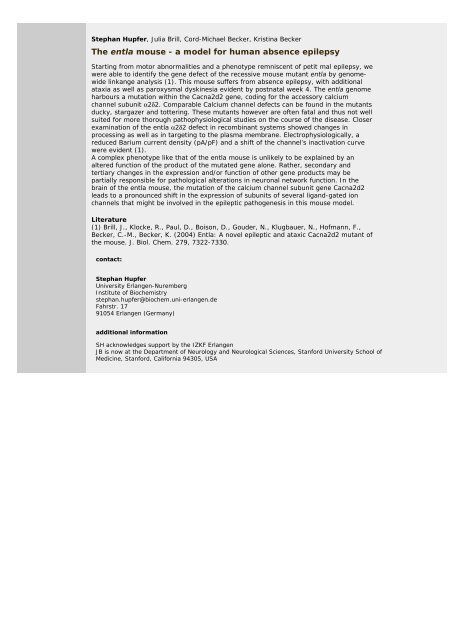Abstracts (poster) - Wissenschaft Online
Abstracts (poster) - Wissenschaft Online
Abstracts (poster) - Wissenschaft Online
You also want an ePaper? Increase the reach of your titles
YUMPU automatically turns print PDFs into web optimized ePapers that Google loves.
Stephan Hupfer, Julia Brill, Cord-Michael Becker, Kristina Becker<br />
The entla mouse - a model for human absence epilepsy<br />
Starting from motor abnormalities and a phenotype remniscent of petit mal epilepsy, we<br />
were able to identify the gene defect of the recessive mouse mutant entla by genomewide<br />
linkange analysis (1). This mouse suffers from absence epilepsy, with additional<br />
ataxia as well as paroxysmal dyskinesia evident by postnatal week 4. The entla genome<br />
harbours a mutation within the Cacna2d2 gene, coding for the accessory calcium<br />
channel subunit α2δ2. Comparable Calcium channel defects can be found in the mutants<br />
ducky, stargazer and tottering. These mutants however are often fatal and thus not well<br />
suited for more thorough pathophysiological studies on the course of the disease. Closer<br />
examination of the entla α2δ2 defect in recombinant systems showed changes in<br />
processing as well as in targeting to the plasma membrane. Electrophysiologically, a<br />
reduced Barium current density (pA/pF) and a shift of the channel’s inactivation curve<br />
were evident (1).<br />
A complex phenotype like that of the entla mouse is unlikely to be explained by an<br />
altered function of the product of the mutated gene alone. Rather, secondary and<br />
tertiary changes in the expression and/or function of other gene products may be<br />
partially responsible for pathological alterations in neuronal network function. In the<br />
brain of the entla mouse, the mutation of the calcium channel subunit gene Cacna2d2<br />
leads to a pronounced shift in the expression of subunits of several ligand-gated ion<br />
channels that might be involved in the epileptic pathogenesis in this mouse model.<br />
Literature<br />
(1) Brill, J., Klocke, R., Paul, D., Boison, D., Gouder, N., Klugbauer, N., Hofmann, F.,<br />
Becker, C.-M., Becker, K. (2004) Entla: A novel epileptic and ataxic Cacna2d2 mutant of<br />
the mouse. J. Biol. Chem. 279, 7322-7330.<br />
contact:<br />
Stephan Hupfer<br />
University Erlangen-Nuremberg<br />
Institute of Biochemistry<br />
stephan.hupfer@biochem.uni-erlangen.de<br />
Fahrstr. 17<br />
91054 Erlangen (Germany)<br />
additional information<br />
SH acknowledges support by the IZKF Erlangen<br />
JB is now at the Department of Neurology and Neurological Sciences, Stanford University School of<br />
Medicine, Stanford, California 94305, USA

















